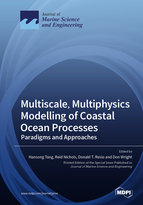Multiscale, Multiphysics Modelling of Coastal Ocean Processes: Paradigms and Approaches
A special issue of Journal of Marine Science and Engineering (ISSN 2077-1312).
Deadline for manuscript submissions: closed (30 April 2020) | Viewed by 26439
Special Issue Editors
Interests: fluid mechanics; numerical methods; computational physics
Interests: ocean observations; model testing; date analytics; operations research
Interests: coastal and ocean engineering; meteorology; hydrodynamics
Interests: science of collaboration; marine science; coastal morphodynamics
Special Issues, Collections and Topics in MDPI journals
Special Issue Information
Dear Colleagues,
It is now important to develop high-fidelity modelling capabilities to simulate multiscale and multiphysics coastal ocean processes, to collect disparate types of date (e.g., time series, imagery, and bathymetry) for model development, and to build confidence in modelling results for applications in operations. Coastal ocean processes involve various types of physical phenomena over a large range of temporal and spatial scales that co-exist and interact. Vital examples are tidal power extraction, oil spill transport and dispersion, propagation and breaking of internal waves, compound coastal flooding, and coastal morphodynamics.
Conventionally, individual coastal ocean phenomena are isolated during modelling and often over simplified or parameterized when they are combined into larger systems using simplistic assumptions, suggesting that direct, high-fidelity simulations must be done to improve the modelling of multiphysics problems. In recent years, emphasis on the needs for better modelling capabilities has led to progress in simulation methods for complex systems (e.g., adaptive mesh resolution, wave-current coupling, ocean–river coupling, and better representation of physics), computer software, and date collation for validation. However, the needs and challenges remain to further the progress.
This Special Issue focuses on papers about necessities, difficulties, and approaches of multiscale and multiphysics modelling, and it includes contributions on assessment of existing models, analysis on their limitations, new methods, model validation, and case studies. It will also focus on collecting and sharing seminal datasets that support model calibration and testing. We welcome high-quality papers from but not limited to the following areas:
- Computational methods
- Physical oceanography
- Marine sciences
- Hydrology
- Environmental science
- Coastal engineering
- Ocean observations
- Laboratory experiments
Contributions to this issue will serve as bases and benchmarks, identify future efforts, and lead to better capabilities to simulate multiscale and multiphysics flow problems and to new paradigms for treating various scientific and engineering problems. It is expected that each submission adheres to the focus of this issue, in particular, it contains discussions on flow phenomena of different types (e.g., ocean currents, surface waves, and internal waves), at different scales (e.g., estuary scale and regional scale), and their interaction and relation.
Interested contributors are encouraged to contact the editors, even a little after the closing date.
Prof. Hansong Tang
Mr. C. Reid Nichols
Prof. Donald T. Resio
Dr. Don Wright
Guest Editors
Manuscript Submission Information
Manuscripts should be submitted online at www.mdpi.com by registering and logging in to this website. Once you are registered, click here to go to the submission form. Manuscripts can be submitted until the deadline. All submissions that pass pre-check are peer-reviewed. Accepted papers will be published continuously in the journal (as soon as accepted) and will be listed together on the special issue website. Research articles, review articles as well as short communications are invited. For planned papers, a title and short abstract (about 100 words) can be sent to the Editorial Office for announcement on this website.
Submitted manuscripts should not have been published previously, nor be under consideration for publication elsewhere (except conference proceedings papers). All manuscripts are thoroughly refereed through a single-blind peer-review process. A guide for authors and other relevant information for submission of manuscripts is available on the Instructions for Authors page. Journal of Marine Science and Engineering is an international peer-reviewed open access monthly journal published by MDPI.
Please visit the Instructions for Authors page before submitting a manuscript. The Article Processing Charge (APC) for publication in this open access journal is 2600 CHF (Swiss Francs). Submitted papers should be well formatted and use good English. Authors may use MDPI's English editing service prior to publication or during author revisions.
Keywords
- Multiscale and multiphysics
- Coastal ocean processes
- Model assessment and limitation
- Model coupling
- Mesh resolution
- Date analysis
- Testbeds









